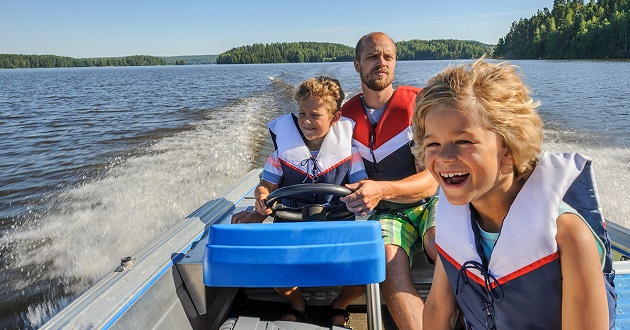Running through a pre-departure checklist before getting on a boat is a great practice to make sure you don’t leave the safety of the dock without the essential items. Recreational vessels should not be exempt from this practice, especially when it comes to personal safety equipment on board.

The gear that one requires is different for day trips and for boats with sleeping cabins. Motorboats and sailboats, small and large boats – they all have their specific safety issues, however, there are pieces of gear that are simply a must. Not only on your pre-departure checklist, and not just because it is dangerous not to adhere to such guidelines, but also in terms of complying with legal requirements for cruising.
Life Jackets
Personal safety on the water starts with life jackets and vests. Everyone on board is required to wear one at all times while underway. They come in different designs and are made from various materials. And on top of that, both instructional materials and government regulations sometimes use them interchangeably with ‘personal flotation device’ or ‘PFDS’. Are you wondering what is the difference between a life jacket and a personal flotation device? You are not alone. The most basic distinction is that life vests are made for helping an unconscious person, while PFDS are made to assist a conscious person.

Life jackets come with air chambers that are joined together with a buckle. They are usually inflated by pulling a trigger and keep the person afloat while restricting their movement. Their focus is on saving lives, hence the design. PFD jackets focus on comfort and are more popular with watersport enthusiasts because they allow higher degree of freedom of movement.
Being a good swimmer doesn’t mean you’re exempted from wearing a PFD vest because anyone can drown in an open water. It doesn’t take much. Improper change of tack on a sailboat can quickly send the boom of the main mast from one side of the deck to the other. This boom can end up hitting an experienced crew member and render them unconscious before sending them in the water. You can imagine what can happen during kite surfing or jet skiing.
Life saving vest design is advanced and protects the most vulnerable. It’s easy to find reliable life jackets for people of all ages and statures, for kids and even for dogs. Before reaching for your wallet, make sure the items you intend to buy comply with Australian maritime safety standards. And don’t forget that it’s not enough to have boat life jackets tucked under the deck. They should be worn and every member of the crew and the guests should be briefed on using them before leaving a marina.
Throwable Flotation Devices

These are buoyancy aids and they are different than safety water vests because they are not worn by anyone. It can be a cushion or buoy in a circular shape, and it is advisable to have several different types of throwable buoys on board. Attaching a line to such devices increases the chances of puling up a person closer to the boat.
It’s very important to have them because you can never know when you might need them. One cannot pass a boating training course without performing a successful recovery of a person that has fallen into the water. Known as the ‘man overboard’ scenario, this drill is impossible to accomplish without such buoyancy aids.
It might seem easy bringing someone back to the boat on a spotless day in calm waters. But, if you are offshore in choppy waters with few meter waves and there is no one else around the situation can quickly turn dire. Make sure to have them on board at all times!
Flares

Boat owners are legally obliged to follow safety standards concerning the provisioning of visual signaling devices onboard a vessel. These are pyrotechnic devices (also known as flares) which emit highly visible smoke (orange, white or red) when launched. Coast authorities can inspect your distress signaling equipment and it has to be good for use (they usually expire after three years).
The range of visibility for fired flare differs according to the weather conditions and time of day, however, there are some generally accepted standards as to what you can expect should you need to launch one. A parachute flare is visible within a range of 25-35 nautical miles, can be fired at night and it emits red light. Red hand flare is similar to the parachute flare but it can be seen within 5-10 nautical miles. Orange smoke flares are only used in daylight and can be seen slightly over 1 nm.
Many lives have been saved because of timely launching of flares in open water. Please note that misuse of this distress signal can result in hefty fines.
Fire Extinguisher

Properly handling fire on a boat is very important. There are engines, sometimes there is propane (or LPG), there are fuel jerry cans and a host of other flammable objects on each boat. Regular engine maintenance and good organization will make firefighting easier. You need at least one fire extinguisher (two if your boat is over 12 meters). Practice putting out a fire: you pull the pin, squeeze the handle and go for the source of the flame.
These are the basic pieces of gear for boating safety. You can extend your emergency gear to include an emergency position indicating radio beacon (EPIRB), a personal locator beacon (PLB) and a life raft. You can stock your inflatable dinghy with emergency supplies (food, water, basic navigation, signal gear). They specifically apply to multi-day trips, ocean crossings and live-aboard sailors.


